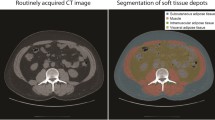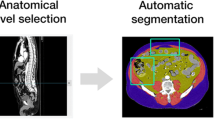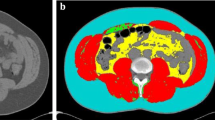Abstract
Objectives
To quantify the effect of IV contrast, tube current and slice thickness on skeletal muscle cross-sectional area (CSA) and density (SMD) on routine CT.
Methods
CSA and SMD were computed on 216 axial CT images obtained at the L3 level in 72 patients with variations in IV contrast, slice thickness and tube current. Intra-patient mean difference (MD), 95 % CI and limits of agreement were calculated using the Bland-Altman approach. Inter- and intra-analyst agreement was evaluated.
Results
IV contrast significantly increased CSA by 1.88 % (MD 2.33 cm2; 95 % CI 1.76–2.89) and SMD by 5.99 % (p<0.0001). Five mm slice thickness significantly increased mean CSA by 1.11 % compared to 2 mm images (1.32 cm2; 0.78–1.85) and significantly decreased SMD by 11.64 % (p<0.0001). Low tube current significantly decreased mean CSA by 4.79 % (6.44 cm2; 3.78–9.10) and significantly increased SMD by 46.46 % (p<0.0001). Inter- and intra-analyst agreement was excellent.
Conclusions
IV contrast, slice thickness and tube current significantly affect CSA and SMD. Investigators designing and analysing clinical trials using CT for body composition analysis should report CT acquisition parameters and consider the effect of slice thickness, IV contrast and tube current on myometric data.
Key Points
• Intravenous contrast, slice thickness and tube current significantly affect myometric data.
• Image acquisition parameter variations may obscure intrapatient muscle differences on serial measurements.
• Investigators using CT for body composition analysis should report CT acquisition parameters.






Similar content being viewed by others
References
Martin L, Birdsell L, Macdonald N et al (2013) Cancer cachexia in the age of obesity: skeletal muscle depletion is a powerful prognostic factor, independent of body mass index. J Clin Oncol 31:1539–1547
Gomez-Perez SL, Haus JM, Sheean P et al (2016) Measuring Abdominal Circumference and Skeletal Muscle From a Single Cross-Sectional Computed Tomography Image: A Step-by-Step Guide for Clinicians Using National Institutes of Health ImageJ. JPEN J Parenter Enteral Nutr 40:308–318
Malietzis G, Johns N, Al-Hassi HO et al (2016) Low Muscularity and Myosteatosis Is Related to the Host Systemic Inflammatory Response in Patients Undergoing Surgery for Colorectal Cancer. Ann Surg 263:320–325
Moisey LL, Mourtzakis M, Cotton BA et al (2013) Skeletal muscle predicts ventilator-free days, ICU-free days, and mortality in elderly ICU patients. Crit Care 17:R206
Prado CM, Lieffers JR, McCargar LJ et al (2008) Prevalence and clinical implications of sarcopenic obesity in patients with solid tumours of the respiratory and gastrointestinal tracts: a population-based study. Lancet Oncol 9:629–635
Englesbe MJ, Lee JS, He K et al (2012) Analytic morphomics, core muscle size, and surgical outcomes. Ann Surg 256:255–261
Boutin RD, Yao L, Canter RJ, Lenchik L (2015) Sarcopenia: Current Concepts and Imaging Implications. AJR Am J Roentgenol 205:W255–W266
Tamandl D, Paireder M, Asari R, Baltzer PA, Schoppmann SF, Ba-Ssalamah A (2015) Markers of sarcopenia quantified by computed tomography predict adverse long-term outcome in patients with resected oesophageal or gastro-oesophageal junction cancer. Eur Radiol. https://doi.org/10.1007/s00330-015-3963-1
Sjoblom B, Gronberg BH, Wentzel-Larsen T et al (2016) Skeletal muscle radiodensity is prognostic for survival in patients with advanced non-small cell lung cancer. Clin Nutr. https://doi.org/10.1016/j.clnu.2016.03.010
Rollins KE, Tewari N, Ackner A et al (2016) The impact of sarcopenia and myosteatosis on outcomes of unresectable pancreatic cancer or distal cholangiocarcinoma. Clin Nutr 35:1103–1109
Chu MP, Lieffers J, Ghosh S et al (2015) Skeletal muscle radio-density is an independent predictor of response and outcomes in follicular lymphoma treated with chemoimmunotherapy. PLoS One 10:e0127589
McDonald AM, Swain TA, Mayhew DL et al (2016) CT Measures of Bone Mineral Density and Muscle Mass Can Be Used to Predict Noncancer Death in Men with Prostate Cancer. Radiology. https://doi.org/10.1148/radiol.2016160626:160626
Lee H, Troschel FM, Tajmir S et al (2017) Pixel-Level Deep Segmentation: Artificial Intelligence Quantifies Muscle on Computed Tomography for Body Morphometric Analysis. J Digit Imaging 30:487–498
Cohen JG, Goo JM, Yoo RE et al (2016) The effect of late-phase contrast enhancement on semi-automatic software measurements of CT attenuation and volume of part-solid nodules in lung adenocarcinomas. Eur J Radiol 85:1174–1180
Athelogou M, Kim HJ, Dima A et al (2016) Algorithm Variability in the Estimation of Lung Nodule Volume From Phantom CT Scans: Results of the QIBA 3A Public Challenge. Acad Radiol 23:940–952
Boutin RD, Kaptuch JM, Bateni CP, Chalfant JS, Yao L (2016) Influence of IV Contrast Administration on CT Measures of Muscle and Bone Attenuation: Implications for Sarcopenia and Osteoporosis Evaluation. AJR Am J Roentgenol. https://doi.org/10.2214/AJR.16.16387:1-9
Mitsiopoulos N, Baumgartner RN, Heymsfield SB, Lyons W, Gallagher D, Ross R (1998) Cadaver validation of skeletal muscle measurement by magnetic resonance imaging and computerized tomography. J Appl Physiol (1985) 85:115–122
Bland JM, Altman DG (1986) Statistical methods for assessing agreement between two methods of clinical measurement. Lancet 1:307–310
Singh S, Kalra MK, Do S et al (2012) Comparison of hybrid and pure iterative reconstruction techniques with conventional filtered back projection: dose reduction potential in the abdomen. J Comput Assist Tomogr 36:347–353
Singh S, Kalra MK, Gilman MD et al (2011) Adaptive statistical iterative reconstruction technique for radiation dose reduction in chest CT: a pilot study. Radiology 259:565–573
Singh S, Kalra MK, Hsieh J et al (2010) Abdominal CT: comparison of adaptive statistical iterative and filtered back projection reconstruction techniques. Radiology 257:373–383
Weijs PJ, Looijaard WG, Dekker IM et al (2014) Low skeletal muscle area is a risk factor for mortality in mechanically ventilated critically ill patients. Crit Care 18:R12
Mueller N, Murthy S, Tainter CR et al (2016) Can Sarcopenia Quantified by Ultrasound of the Rectus Femoris Muscle Predict Adverse Outcome of Surgical Intensive Care Unit Patients as well as Frailty? A Prospective, Observational Cohort Study. Ann Surg 264:1116–1124
Temel JS, Abernethy AP, Currow DC et al (2016) Anamorelin in patients with non-small-cell lung cancer and cachexia (ROMANA 1 and ROMANA 2): results from two randomised, double-blind, phase 3 trials. Lancet Oncol 17:519–531
Miljkovic I, Zmuda JM (2010) Epidemiology of myosteatosis. Curr Opin Clin Nutr Metab Care 13:260–264
Goodpaster BH, Kelley DE, Thaete FL, He J, Ross R (2000) Skeletal muscle attenuation determined by computed tomography is associated with skeletal muscle lipid content. J Appl Physiol (1985) 89:104–110
Mamane S, Mullie L, Piazza N et al (2016) Psoas Muscle Area and All-Cause Mortality After Transcatheter Aortic Valve Replacement: The Montreal-Munich Study. Can J Cardiol 32:177–182
Reisinger KW, van Vugt JL, Tegels JJ et al (2015) Functional compromise reflected by sarcopenia, frailty, and nutritional depletion predicts adverse postoperative outcome after colorectal cancer surgery. Ann Surg 261:345–352
Yip C, Dinkel C, Mahajan A, Siddique M, Cook GJ, Goh V (2015) Imaging body composition in cancer patients: visceral obesity, sarcopenia and sarcopenic obesity may impact on clinical outcome. Insights Imaging 6:489–497
Prado CM, Heymsfield SB (2014) Lean tissue imaging: a new era for nutritional assessment and intervention. JPEN J Parenter Enteral Nutr 38:940–953
Solomon JB, Christianson O, Samei E (2012) Quantitative comparison of noise texture across CT scanners from different manufacturers. Med Phys 39:6048–6055
Soderberg M, Gunnarsson M (2010) Automatic exposure control in computed tomography--an evaluation of systems from different manufacturers. Acta Radiol 51:625–634
Rosset A, Spadola L, Ratib O (2004) OsiriX: an open-source software for navigating in multidimensional DICOM images. J Digit Imaging 17:205–216
Dello SA, Lodewick TM, van Dam RM et al (2013) Sarcopenia negatively affects preoperative total functional liver volume in patients undergoing liver resection. HPB (Oxford) 15:165–169
Reisinger KW, Derikx JP, van Vugt JL et al (2016) Sarcopenia is associated with an increased inflammatory response to surgery in colorectal cancer. Clin Nutr 35:924–927
Tegels JJ, van Vugt JL, Reisinger KW et al (2015) Sarcopenia is highly prevalent in patients undergoing surgery for gastric cancer but not associated with worse outcomes. J Surg Oncol 112:403–407
Haak D, Page CE, Deserno TM (2016) A Survey of DICOM Viewer Software to Integrate Clinical Research and Medical Imaging. J Digit Imaging 29:206–215
Acknowledgements
Georg Fuchs thanks the Rolf W. Günther Foundation for their generous support.
Author information
Authors and Affiliations
Corresponding author
Ethics declarations
Guarantor
The scientific guarantor of this publication is Prof. Dr. med. Florian Fintelmann.
Conflict of interest
The authors of this manuscript declare no relationships with any companies whose products or services may be related to the subject matter of the article.
Statistics and biometry
Yves R. Chretien, M.D., Ph.D. has significant statistical expertise (Ph.D. in Statistics from Harvard University) and kindly provided statistical advice for this manuscript.
Informed consent
Written informed consent was waived by the Institutional Review Board.
Ethical approval
Institutional Review Board approval was obtained.
Methodology
• retrospective
• cross-sectional study
Electronic supplementary material
ESM 1
(DOCX 77 kb)
Rights and permissions
About this article
Cite this article
Fuchs, G., Chretien, Y.R., Mario, J. et al. Quantifying the effect of slice thickness, intravenous contrast and tube current on muscle segmentation: Implications for body composition analysis. Eur Radiol 28, 2455–2463 (2018). https://doi.org/10.1007/s00330-017-5191-3
Received:
Revised:
Accepted:
Published:
Issue Date:
DOI: https://doi.org/10.1007/s00330-017-5191-3




